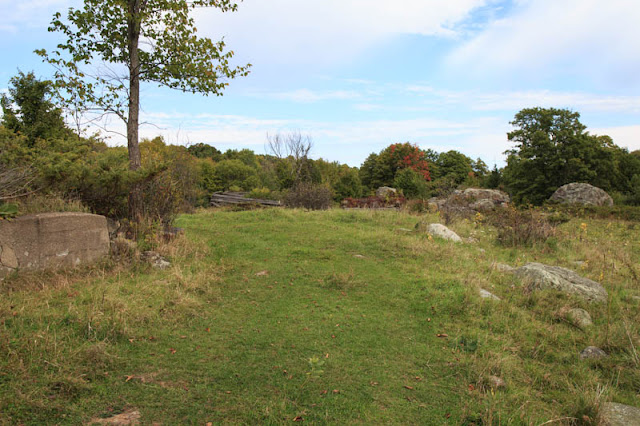By the way, 7.5 hours isn't so bad as it seems when you're stopping somewhat frequently: as we were. Just thought I would get that in there. Especially when you're retired and not punching a clock, ya gotta stop and smell the roses as it were.
It's not much: just a few tumbled down structures in a cow field, but I commiserated deeply with the poor sods who ended up on this barren piece of rocky land.
Before I get to the photos, following are a few extracts from two websites: here and here.
Six kilometres up a trail off of Opeongo Road, across from Davidson’s Corners, are the skeletal remains of Newfoundout, Ontario. Victims of the government’s infamous “Public Land Act” of 1853, 13 families wound their way up the mountainside and for 30 years attempted to eke a living out of the mostly barren, rocky soil. Never able to attract more settlement or institutions, such as schools, the town died, becoming completely abandoned by 1948.
Take the Opeongo Road west from highway 41 for about 5 km to Newfoundout Road and turn left. The Newfoundout Road is NW of the ghost town of Esmonde. Drive up the hill from 1.5 km- 6.5 km to see all the buildings.
Much like the Nipissing Colonization Road, the Opeongo Road was another of the government's road colonization attempts. As people would immigrate to Canada and settle along these roads, they'd clear the land to build a home and farm. However the land proved to be poor for growing and many of these settlers left with broken dreams.
The settlers to the Opeongo Road were given 100 acres of land. The Public Land Act (1853) proclaimed, "One hundred acres will be given free to any settlers, 18 years of age, who shall take possession of the Lot within one month from the date of his application, erect on it a house, 18 by 20 feet, put in a state of cultivation at least 12 acres in the course of four years, and live on the Lot during the period.
Between 1860 and 1890 these families lived in the back part of the colonization road, trying to make a living on their farms. By 1948, the area was completely abandoned.
Onto the photos.
 |
| Looking back at a bit of the road that we drove in on. It was not a welcoming road. |
 |
| Beyond the gate is a cow pasture and woodlot. We trespassed, but I think it was expected and not forbidden. |
There is not much point in captioning the next bunch of photos which depict the state of the old cabins. But notice the surrounding rock in so many of the photos as well as the hilliness. What a place to try to wrest a living from the land! Being the wimp that I am, I never would have made it. (In two of the shots, you can see a cement foundation.)
I found the next two photos somewhat poignant: one remaining post and a few old implements on a rock. I am not sure if the implements date back to the settlers, but I think they speak regardless.
I had wandered around a bit while Sue stayed closer to the car (I don't think her footwear was appropriate for traversing the hilly cow pasture, and btw the evidence for cows was there if you know what I mean).
Anyway, it was pleasant to see milady, and we were soon off to the next stop.











You are tilling ground (so to speak) that our late blogging friend Philip would have enjoyed.
ReplyDeleteThere is such an allure of places where people once "held sway" and then abandoned. I became fascinated some years ago with the tunnels on the Pennsylvania Turnpike that were abandoned...and there are several. With the Internet, all one does is look up the histories. Unlike you, I have not gone on a pilgrimage.
It looks a wonderful place to live.
ReplyDeleteJust absolutely fascinating... I niether have the footwear for this event LOL
ReplyDeleteThat wave looks like she was wondering what had happened to you. That place does look lovely!
ReplyDeleteWhen I read the title of your entry, AC, I thought it was a teaser about something weird from Newfoundland that you'd found. Wrong !! No wonder you veered off the path ... the pictures are amazing, especially the ones of the quarry in your last post.
ReplyDeleteA perfect break on a long drive. ...and a lovely lady waving.
ReplyDeleteIt looks like you two had a fabulous day trip up to the cottage---the only way to go. We all rush too much...sometimes the journey is as good or better than the destination!!
ReplyDeletelots of rocks and too big to move 'em!
ReplyDeleteThank goodness I wasn't one of those settlers back in the 1850s, I would never have survived without my washer and dryer and the dishwasher and the natural gas central heating and my little car driving to the No Frills grocery store for my food. They were brave people indeed. Love the pictures, they tell quite a story!
ReplyDeleteYour photos show very well why the settlements there are now ghost towns. What a hostile environment!
ReplyDeleteLooks like a very interesting place to walk around- of course in good sturdy tennis shoes that can be thrown in the wash if one happens to step in a cow patty!
ReplyDeleteThat's kinda heartbreaking to think of those folks trying to farm that land.
ReplyDelete